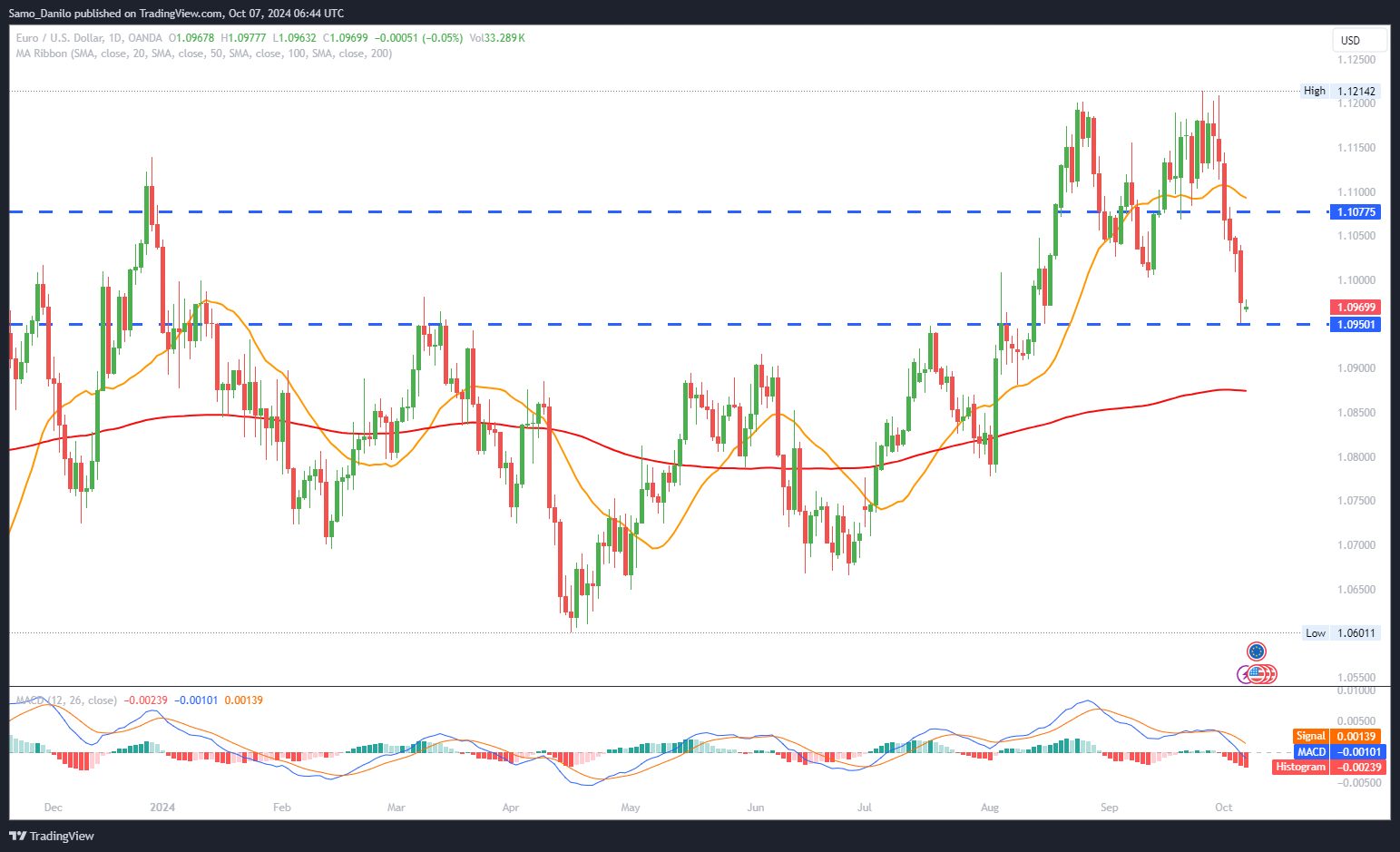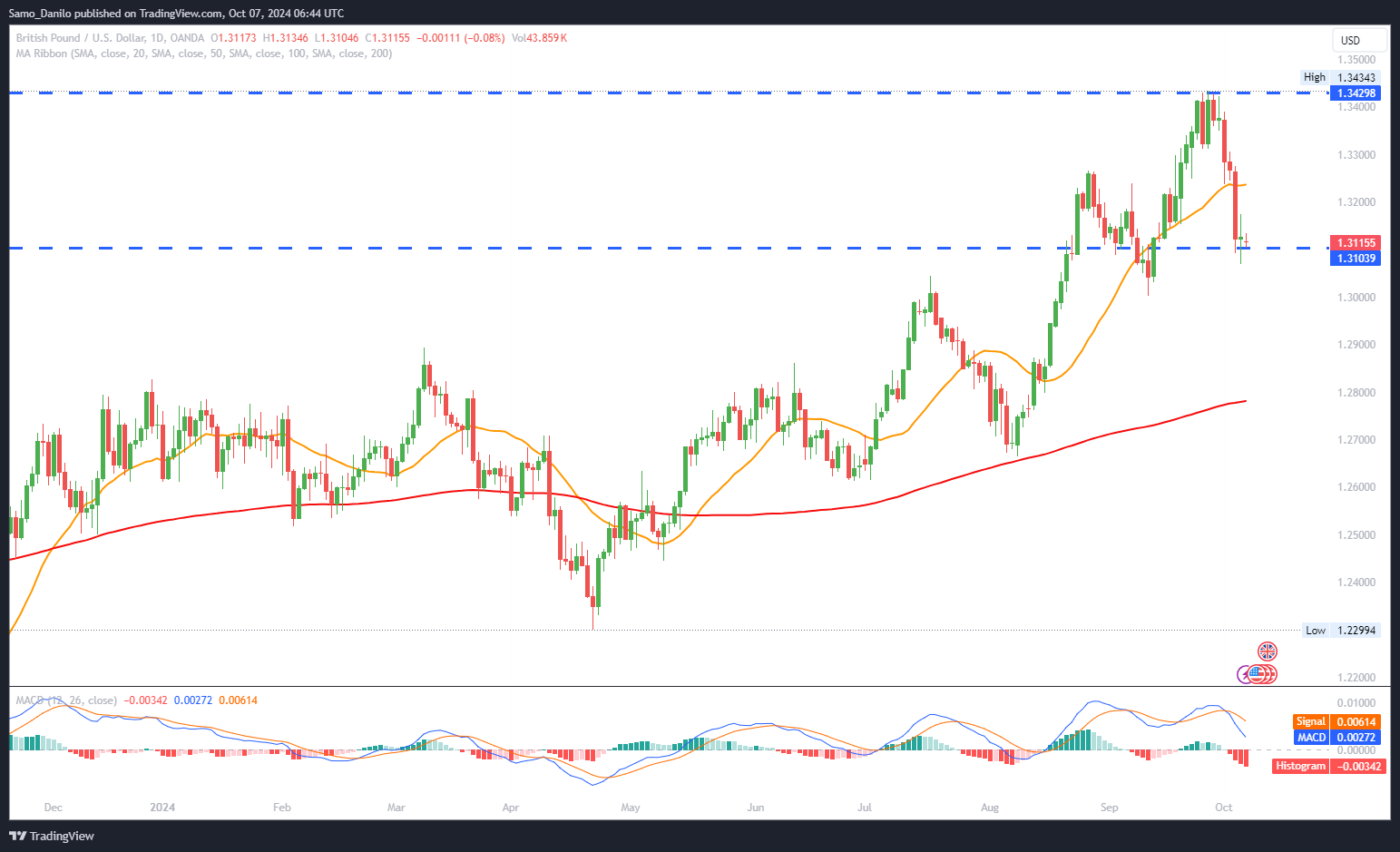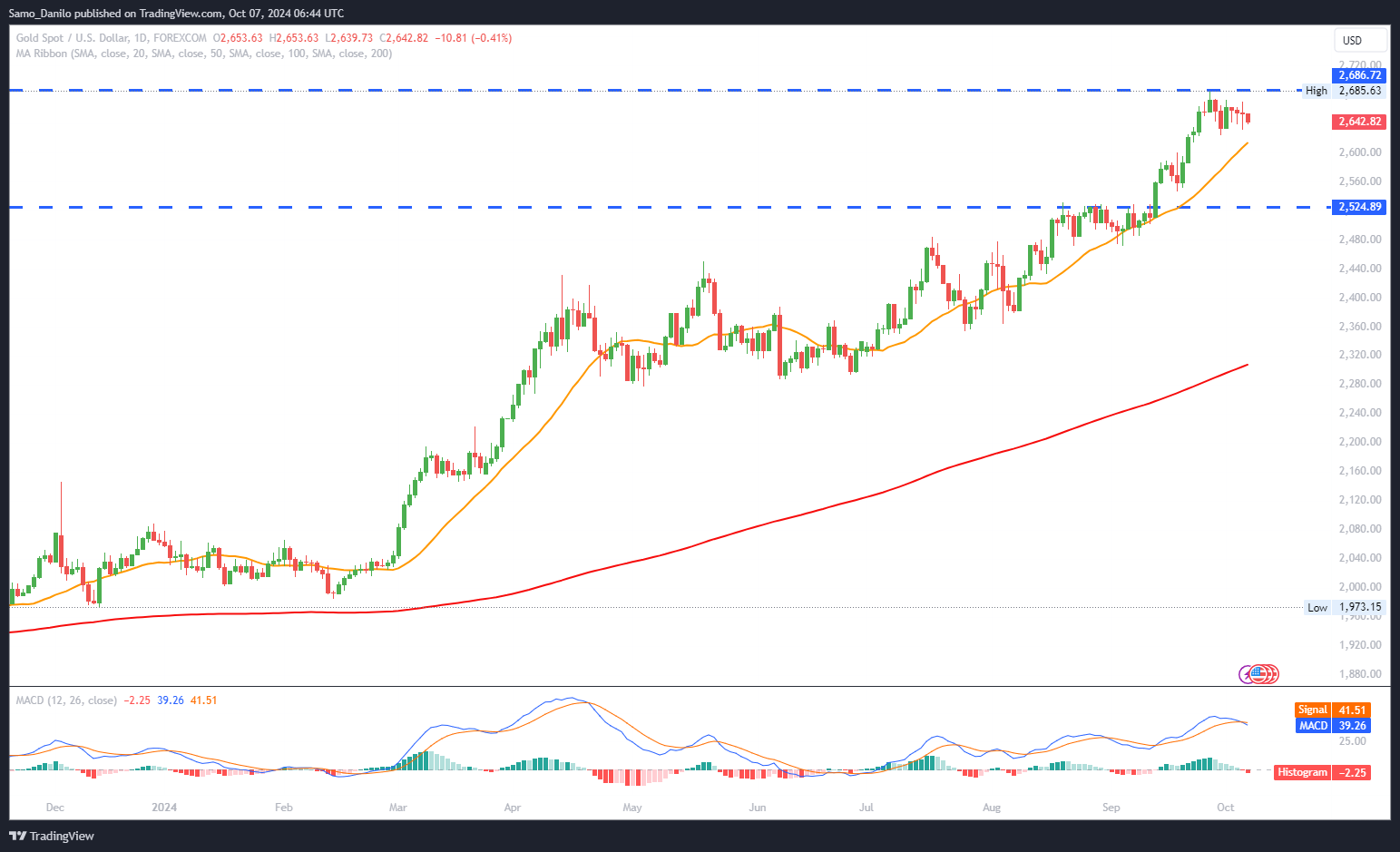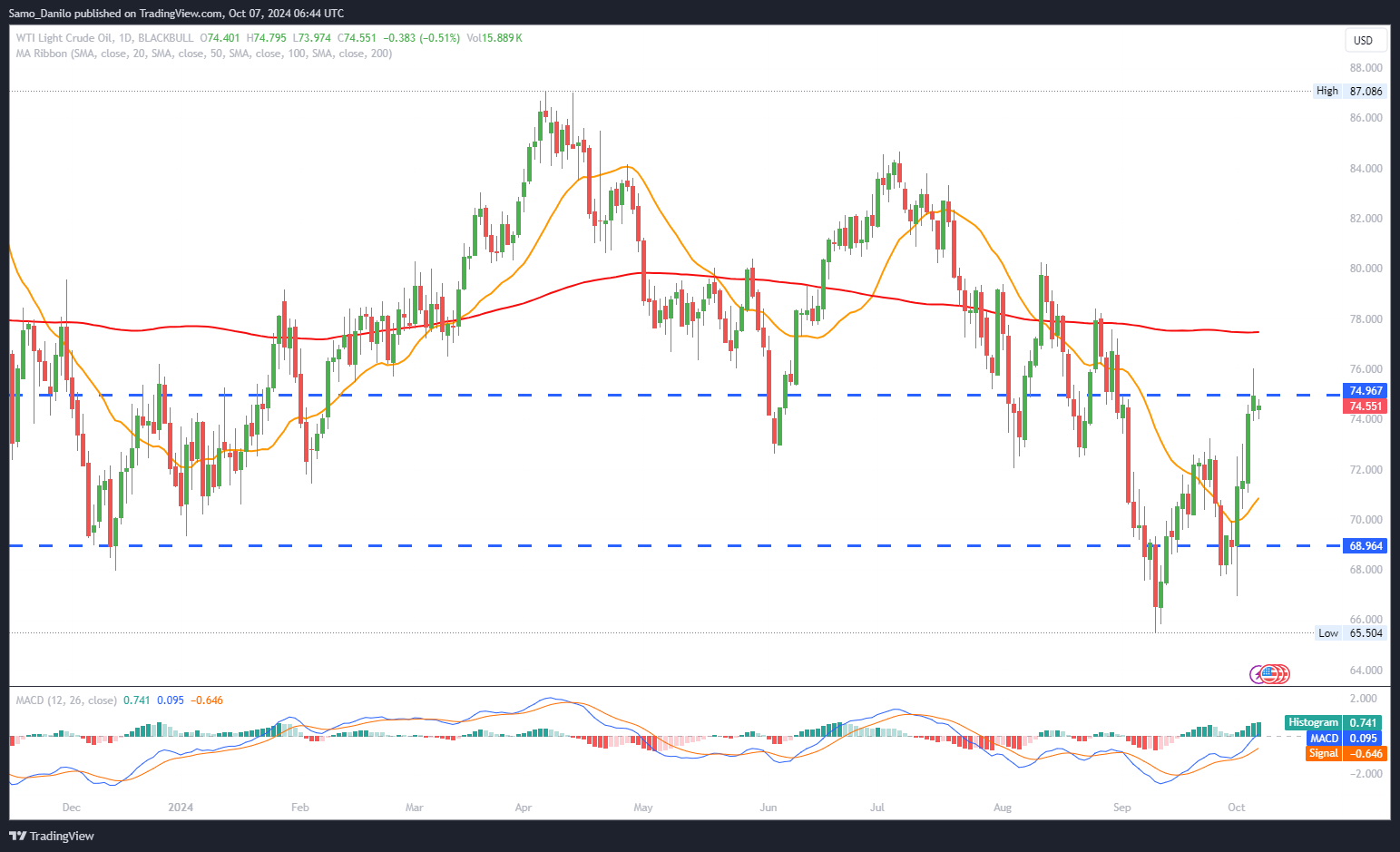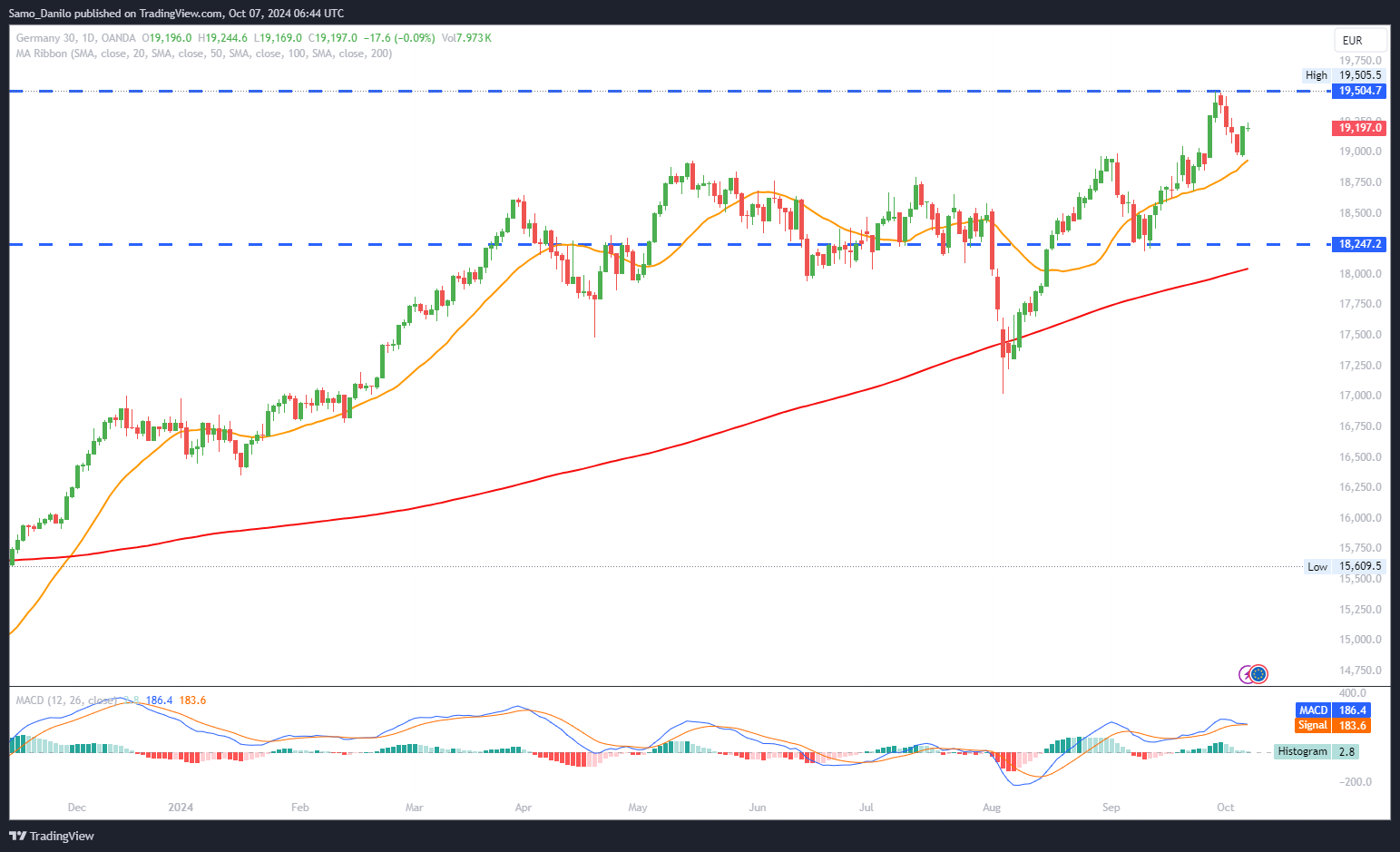EURUSD
- EUR/USD Price: The EUR/USD pair is trading near 1.0950 in early Monday’s European session, holding lower ground. This movement reflects the recent downward pressure on the Euro, driven by economic data and monetary policy expectations.
- US Job Market: The US Nonfarm Payrolls (NFP) report showed a robust increase of 254K jobs in September, well above expectations, while the Unemployment Rate unexpectedly fell to 4.1%. This strong labour market performance supports the narrative of a resilient US economy, boosting the US Dollar against the Euro.
- Fed Rate Cut Expectations: Despite the positive job data, markets still see a nearly 95% probability that the Federal Reserve will cut interest rates by 25 basis points at the November 7 policy meeting. This dovish outlook has tempered the USD’s gains, as traders anticipate a shift in Fed policy toward monetary easing.
- Weak Euro Sentiment: The Euro remains under pressure due to growing expectations that the ECB will cut rates again in October. Easing inflationary pressures and a weakening economic outlook have led to increased speculation of further monetary stimulus by the ECB, weighing heavily on the shared currency.
- ECB Officials: Comments from ECB Governing Council member François Villeroy de Galhau reinforced expectations for an October rate cut. He noted that the central bank is likely to reduce rates further as the risk of inflation falling below the 2% target rises, given the ongoing economic slowdown in the Eurozone.
Closing statement: EUR/USD remains under selling pressure as diverging monetary policy outlooks between the Fed and ECB shape market sentiment. While the Fed is seen as nearing the end of its tightening cycle, strong US labour data provides underlying support to the USD. Meanwhile, expectations of further ECB rate cuts continue to drag the Euro lower. In the near term, the pair could test support around 1.0900 if dovish ECB expectations intensify.
GBPUSD
- GBP/USD Price: The GBP/USD pair defends the 1.3100 level during Monday’s European session, giving back earlier gains as the market digests the implications of recent economic data and central bank outlooks. The pair remains pressured amid mixed fundamentals, struggling to establish a clear directional bias.
- Strong US Data: The stronger-than-expected US Nonfarm Payrolls (NFP) report for September, which showed an increase of 254K jobs and a drop in the Unemployment Rate to 4.1%, has reduced bets on aggressive Federal Reserve rate cuts. While markets still anticipate some easing, the reduced probability of near-term cuts is providing underlying support for the US Dollar.
- US Wage Growth: Average Hourly Earnings in the US rose by 3.8% YoY in September, up from 3.6% in August, indicating firm wage growth and adding to the narrative of a robust labour market. This data complicates the Fed’s decision-making process, as strong wage growth typically exerts upward pressure on inflation, limiting the scope for immediate monetary easing.
- BoE Rate Cut Outlook: The Pound Sterling edged higher briefly as investors priced in a potentially more aggressive approach from the Bank of England (BoE) on rate cuts. However, the market’s enthusiasm was tempered by recent comments from BoE Chief Economist Huw Pill, who advocated for a gradual approach to easing monetary policy, reflecting a cautious stance.
- BoE’s Officials: Huw Pill’s comments suggest that while the BoE is leaning toward reducing rates, it prefers a measured pace to avoid destabilizing the economy. This stance has prevented the GBP from capitalizing significantly on the Fed’s tempered rate cut outlook, leaving the pair vulnerable to broader market sentiment and risk appetite.
| SMA (20) | Rising |
|
|
| RSI (14) | Falling |
|
|
| MACD (12, 26, 9) | Falling |
|
|
Closing statement: GBP/USD remains under pressure as a resilient US labour market limits Fed rate cut bets, while the BoE’s cautious approach to easing fails to provide meaningful support for the GBP. The pair could remain range-bound near 1.3100 until clearer signals emerge from both central banks. If the Fed maintains a less dovish tone, GBP/USD may drift lower, potentially testing 1.3050 in the short term.
GOLD
- Gold Price: Gold started the week in negative territory on Monday, trading around $2,650 but still within its established range. Despite the early losses, the precious metal has not shown a decisive move, reflecting a lack of strong catalysts to push it out of its consolidation phase.
- Chinese Stimulus: Risk-on flows are evident in the market as traders anticipate additional economic stimulus measures from China following the country’s week-long holiday. Optimism around Chinese economic support tends to reduce the safe-haven demand for gold, thereby limiting its upside potential.
- China’s Gold Purchases: The People’s Bank of China (PBOC) reported no new gold purchases for the fifth consecutive month in September, raising concerns about demand from the world’s largest gold consumer. This prolonged pause in reserve accumulation by the PBOC is adding a bearish undertone to gold prices, as China’s demand significantly impacts the global gold market.
- Geopolitical Tensions: Gold has managed to limit its downside correction, mainly due to the ongoing geopolitical tensions between Israel and Iran. The conflict has increased safe-haven buying interest, preventing gold from falling further despite the generally risk-on mood in broader financial markets.
- Fed Speak and Upcoming Data: Gold traders are now eyeing speeches from US Federal Reserve policymakers and the upcoming US Consumer Price Index (CPI) data for fresh direction. The Fed’s commentary and inflation data will likely shape the market’s expectations for future monetary policy, which could have a significant impact on gold’s near-term trend.
| SMA (20) | Rising |
|
|
| RSI (14) | Rising |
|
|
| MACD (12, 26, 9) | Rising |
|
|
Closing statement: XAU/USD is caught between mixed fundamentals, with geopolitical risks providing a floor for prices, while positive sentiment on Chinese stimulus and the absence of fresh demand from the PBOC weigh on upside potential. The pair is likely to remain range-bound until more clarity emerges from the Fed’s guidance and US inflation data. A break above $2,670 could signal a bullish extension, while a dip below $2,620 may open the door for further losses.
CRUDE OIL
- Crude Oil Price: West Texas Intermediate (WTI) crude oil prices began Monday’s session on a bearish note, retreating from a five-month high above the $75.00 psychological mark reached on Friday. This pullback suggests some profit-taking by traders after the strong rally in recent sessions.
- US Employment Data: Friday’s robust US employment report, which showed a stronger-than-expected increase in jobs, improved market sentiment regarding the health of the world’s largest economy. A stronger economy generally translates into higher energy demand, but this outlook has yet to provide consistent support for crude oil prices early in the week.
- China Stimulus: Hopes that China’s recent stimulus measures will bolster its economic recovery and fuel demand have kept the long-term outlook for crude oil relatively positive. Being the world’s largest oil importer, a sustained recovery in China’s economy could significantly support global oil consumption and prices.
- Fedspeak: With no major US economic data releases on Monday, traders will closely monitor speeches from Federal Open Market Committee (FOMC) members for clues on future US interest rate policy. Given that crude oil is priced in USD, any hints from the Fed about policy shifts could influence oil prices through fluctuations in the value of the USD.
- Geopolitical Uncertainty: Ongoing conflicts in the Middle East, particularly tensions involving Iran and Israel, remain a key factor driving short-term price volatility. Any escalation in the region could disrupt supply chains and create sharp movements in crude oil prices, presenting both opportunities and risks for traders.
| SMA (20) | Falling |
|
|
| RSI (14) | Rising |
|
|
| MACD (12, 26, 9) | Rising |
|
|
Closing statement: Crude oil prices have pulled back from recent highs as traders digest robust US employment data and weigh the implications of potential Fed policy changes. Expectations of stronger Chinese demand and ongoing geopolitical tensions provide a mixed backdrop. For now, WTI may consolidate within a range unless there is a fresh catalyst, such as significant Fed guidance or a major escalation in the Middle East. A sustained break above $75.00 could resume the bullish trend, while a move below $72.50 might signal deeper corrections.
DAX
- DAX Price: The DAX index gained 0.55% on Friday, partially offsetting a 0.78% decline from the previous day. This rebound ended a four-session losing streak, providing some respite to investors, although the index closed the week down 1.81%, reflecting the overall cautious sentiment due to external geopolitical factors.
- Auto Stocks: Auto stocks were a key driver of Friday's recovery, buoyed by news that the European Union is considering tariffs on Chinese electric vehicle (EV) imports. This potential protective measure spurred investor optimism for local automakers. Volkswagen surged 2.85%, while BMW and Porsche posted strong gains of 1.75% and 1.74%, respectively, highlighting the positive sector-specific momentum.
- Middle East Conflict: Despite the gains, the broader market remains vulnerable to geopolitical risks. The escalating conflict in the Middle East continued to weigh on investor sentiment, limiting the DAX’s upside potential. Traders remain cautious as any further escalation could impact global supply chains and disrupt economic stability.
- Factory Orders: Germany’s Factory Orders data for August painted a bleak picture for the country’s industrial sector, falling by 5.8% after an unexpected 3.9% rise in July. This sharp downturn suggests that the recovery momentum in the manufacturing sector may have stalled, raising concerns over the health of Europe’s largest economy.
- Eurozone Retail Sales: Investors are also watching retail sales data from the Eurozone, which is forecast to rise by 0.2% in August, up slightly from 0.1% in July. A weaker-than-expected reading could further dent confidence in the region’s economic outlook, potentially affecting demand for DAX-listed retail and consumer stocks.
| SMA (20) | Rising |
|
|
| RSI (14) | Slightly Rising |
| |
| MACD (12, 26, 9) | Rising |
|
|
Closing statement: The DAX managed a modest recovery, driven primarily by strength in auto stocks amid hopes of EU measures against Chinese EV imports. However, concerns about geopolitical instability and weak German economic data could limit gains in the near term. Investors will remain sensitive to geopolitical developments and upcoming macroeconomic indicators, with a break above 15,500 necessary to regain bullish momentum, while a sustained move below 15,000 could signal further downside risk.
